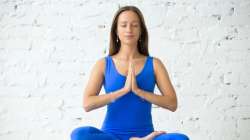International Yoga Day 2022: 5 Yoga poses to relieve stress and rejuvenate mind
Yoga is beneficial to both mental and physical wellness. When inner peace is nowhere to be found, it's time to tune into the body. So, set aside just a few minutes each day to practice any of these poses, as the key to maintaining that zen and unlocking yoga's benefits by making a habit out of that practice.

Annually International Yoga Day 2022 is celebrated on June 21 to educate people about Yoga's importance and the pivotal role it plays in leading towards a healthier lifestyle by rejuvenating our mind and body. In recent years, mental diseases of various kinds have become a serious worldwide health burden. An increase in the incidence of anxiety and depression is being attributed to unhealthy lifestyles, poor eating habits, and increased work-related stress. People with poor mental health can reap rich and long term benefits by practicing Yoga into their everyday life.
Yoga is beneficial to both mental and physical wellness. It balances our emotions and harmonizes our body and mind. It's evident that yoga can help people with depression, anxiety, and Attention-Deficit/Hyperactivity Disorder (ADHD). Stress leads to most lifestyle diseases. Yoga is a scientific approach that helps people cope up with stress & anxiety. Yoga also helps senior people with minor memory loss, it improves their memory, sleep, and overall quality of life.
Below are the best Yoga Asanas to help deal with mental health, stress & anxiety:
Balasana
Excellent for relieving stress and anxiety, this pose involves curling up into a ball with your knees tucked under you and your chest near the mat. Keep your arms out in front of you and rest your forehead on the mat. Stay in that position for at least 10 deep breaths.
Anulom Vilom
It's a specific type of pranayama, or controlled breathing, in yoga. It involves holding one nostril closed while inhaling, then holding the other nostril closed while exhaling. The process is then reversed and repeated. Doing this can bring better balance to your nervous system and less stress response and activity over time.
Vriksasana
Take one foot and place it above the thigh of the supporting leg. Vriksasana is an advanced mountain pose, intended to improve the yogi's balance and concentration. It also helps in strengthening the balancing muscles of our legs.
Shashankasana or Child’s Pose:
This asana re-energises your entire body by stimulating your neurological system. This asana is essentially a resting position that resembles a fetal position for a child. It's done by bending forward till the chest reaches the thighs and the forehead contacts the ground while sitting on the knees. Forward-stretching arms The performer will feel a sense of mental, bodily, and emotional comfort come upon him or her if executed with precision on a regular basis. This asana, like the majority of yoga asanas, should be done on an empty stomach or at least six hours after eating. This asana should be avoided by persons who have high blood pressure or back pain.
Bhujangasana
It is a reclining back-bending asana in hatha yoga. Begin by lying flat in your stomach and lift your upper body. Bhujangasana is said to help relieve stress and it strengthens your arms, shoulders, and upper back.
Savasana
Even if you want to opt-out of every other pose, please don't miss out on this one as it simply involves laying down on your mat with your eyes closed. But from this small, deliberate movement come big changes for your stress levels.
Hasta Utthanasana:
People with high blood pressure, asthma, sinusitis, infertility, and osteoporosis are said to benefit from this yoga position. As a relaxation method, it also aids in the relief of mild depression and the treatment of insomnia. To do this stance, keep your back straight. As you inhale slowly, raise your hands from the front to over your head. Bend backwards from the upper back and hold the position while breathing normally.
Vipareetakaraniasana:
One of the best yoga asanas for boosting blood circulation to the head is this inverted stance. It aids in the reduction of anxiety, the treatment of depression, and the prevention of sleeplessness, as well as the regulation of blood flow. You can accomplish this stance by resting flat on your back. Keep your legs together as much as possible. Raise the legs, buttocks, and trunk while breathing, and support the hips on the palm. The trunk is angled to the ground at a 45-degree angle. In this position, breathe normally. Exhale while lowering the legs over the head and keeping the hands down. Bring the spine and legs down to the floor.
-With inputs from Dr. K. Shanmugam, Asst Chief Medical Officer, Jindal Naturecure Institute